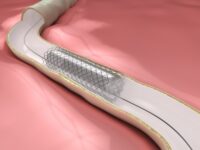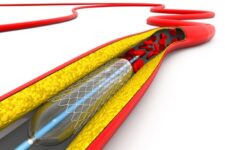Original title: Comparison of everolimus- and biolimus-eluting coronary stents with everolimus-eluting bioresorbable vascular scaffolds. Referencia: Puricel S. et al. J Am Coll Cardiol. 2015 Mar 3;65(8):791-801. The everolimus eluting bioresorbable scaffold (BVS) is effective at treating simple lesions in stable patients but it has yet to be assessed against the best-in-class DES. This study compared BVS performance against…
CTO revascularization is beneficial
Título original: Long-Term Survival Benefit of Revascularization Compared UIT Medical Therapy in Practice UIT Coronary Chronic Total Occlusion and Well-Developed Collateral Circulation. Reference: Woo Jin Jan, el at. J Am Coll Cardiol Interv 2015;8:271-9 Multiple studies have shown the benefit of chronic total occlusion (CTO) revascularization, but for patients presenting Rentrop 3 grade collateral circulation (CC), such benefit…
Double Anti platelet aggregation would be sufficient for six months after angioplasty in patients with stable coronary disease NSTSEACS.
Original title: 6- Versus 24-Month Dual Antiplatelet Therapy After Implantation of Drug. Reference: Eluting Stents in Patients Nonresistant to Aspirin The Randomized, Multicenter ITALIC Trial. JACC.VOL. 65, NO. 8, 2015 Current recommendations on dual antiplatelet therapy (DAPT) are under review, particularly in acute coronary events due largely to the advent of second-generation stents. This work studied the hypothesis…
IVUS plaque regression with high doses of statins
Original title: Effect of high-intensity statin therapy on atherosclerosis in non-infarct-related coronary arteries (IBIS-4): a serial intravascular ultrasonography study. Reference: Räber L et al. Eur Heart J. 2015 Feb 21;36(8):490-500. The long-term effect of intensive statin therapy on coronary atherosclerosis in patients admitted pursuing an ST segment elevation myocardial infarction is unknown. The aim of this study was…
Partial occlusion of coronary sinus reduces refractory angina
Original title: Efficacy of a Device to Narrow the Coronary Sinus in Refractory Angina. Reference: Verheye S et al. N Engl J Med 2015 Feb 5;372(6):519-27. The number of patients with severe diffuse coronary artery disease who are not candidates for revascularization is growing in Western countries, generating multiple procedures and increasing healthcare expenditure. New and unconventional solutions…
Invasive evaluation of patients with angina in the absence of coronary lesions
Original title: Invasive Evaluation of Patients with Angina in the Absence of Obstructive Coronary Artery Disease. Reference: Bong-Ki Lee et al.Circulation published online before print February 20, 2015. More than 20% of patients presenting to the cath lab with angina symptoms have no angiographic evidence of coronary artery disease (CAD). Despite a “normal” angiogram, these patients have persistent…
Linear relationship between prognosis and FFR value
Original title: Prognostic Value of Fractional Flow Reserve Linking Physiologic Severity to Clinical Outcomes. Reference: Nils P. Johnson et al. J Am Coll Cardiol 2014;64:1641–54. Fractional flow reserve (FFR) has become an essential tool for guiding treatment, but its graded relationship to prognosis and its influence by medical treatment vs revascularization, remains unclear. The hypothesis of this study…
Safety and efficacy of DES in saphenous vein bypass graft PCI
Original title: Safety and effectiveness of drug-eluting versus bare-metal stents in saphenous vein bypass graft percutaneous coronary interventions: insights from the Veterans Affairs CART program. Reference: Aggarwal V et al. J Am Coll Cardiol. 2014;64:1825-1836. This study retrospectively evaluated 2471 receiving after saphenous vein graft (SVG) PCI between October and September 2011. Outcomes were compared using propensity…
Tomography vs FFR to identify lesions that cause ischemia
Original title: Atherosclerotic Plaque Characteristics by CT Angiography Identify Coronary Lesions That Cause IschemiaA Direct Comparison to Fractional Flow Reserve. Reference: Hyung-Bok Park et al. J Am CollCardiolImg. 2015;8(1):1-10. This trial evaluated the characteristics of arteriosclerotic plaques and its association with lesion ischemia by CT angiography (CTA) vs fractional flow reserve (FFR). FFR is the gold standard to…
Never ending controversy over the duration of post DES dual antiplatelet therapy
Original title: Second Generation Drug-Eluting Stents Implantation Followed by Six Versus Twelve-Month – Dual Antiplatelet Therapy- The SECURITY Randomized Clinical Trial. Reference: Antonio Colombo et al. J Am CollCardiol. 2014 Nov 18;64(20):2086-97. The optimal duration of dual antiplatelet therapy after second-generation DES implantation is still debated and apparently will remain controversial for some time. The aim of this…
Risks and benefits of Dual Antiplatelet beyond the year of a drug-eluting stent
Original title: Twelve or 30 Months of Dual Antiplatelet Therapy after Drug-Eluting Stents. Reference: Laura Mauri et al. N Engl J Med 2014;371:2155-66. Dual antiplatelet therapy is recommended after a drug-eluting stent to prevent thrombotic complications. The clinical benefit of this scheme it is not clear beyond one year. Patients were registered to receive a…










